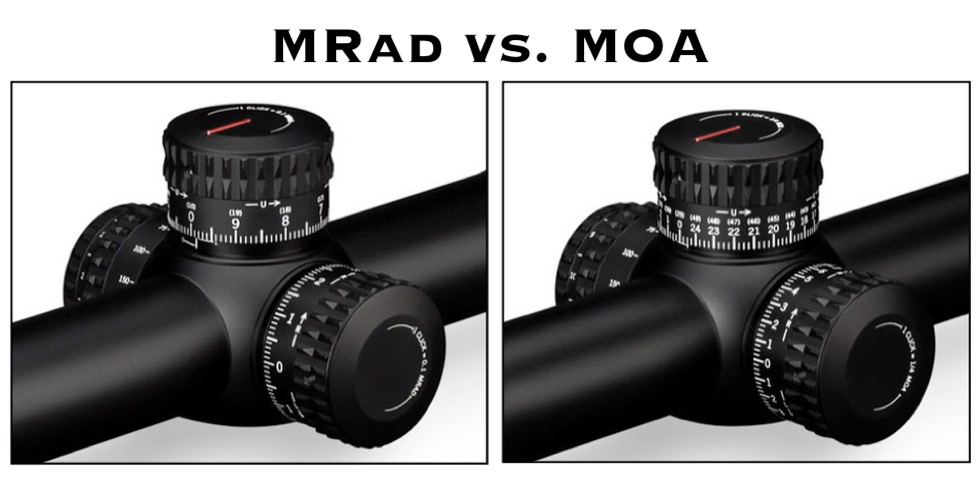When selecting a rifle scope, one of the most important choices you will make is whether to go with a Mil or MOA based system. This relates to the reticle and scope turrets, and how they adjust to account for bullet drop and wind drift. I often get asked the difference between Mil and MOA; in fact this is a question that I probably get asked more than any other when it comes to optics.
But which system is better, and how do you decide which will be more suitable towards you?
Well its quite simple, Mil is a metric based system and MOA is an imperial based system. So if you calculate, think and communicate in meters and centimetres, you will be more suited towards the Mil (or MRad) scope, while if you naturally prefer yards and feet, you will most likely suit the MOA system.
Making the right choice between Mil and MOA can really work in your favour when making trajectory related calculations on the fly, and selecting the right system may be the difference between smooth progressive shooting and interrupted follow-up shots that require a pen and paper.

The Math Behind MRAD
- The Mil system is otherwise known as the Milliradian, MilRad, or MRAD system.
- It is an angular measurement that measures 10cm at 100 meters, or 3.6-inches at 100 yards.
- When using metric measurements, this is easy because it means that 1 click on your scope (0.1 Mils) will move your crosshair 1cm at 100 meters.
- This angle grows in proportion to the range.
- Therefore 1 click equals 5cm at 500 meters, or 10cm at 1000 meters, and so on.
- The system is mathematically easy to work with.
The Math Behind MOA
- Minute of Angle (MOA) is an angular measurement that measures 1.047-inches at 100 yards.
- This measurement is known as True MOA.
- This figure is often rounded off to 1-inch at 100 yards for ease of use, known as a Shooter’s Minute of Angle (SMOA).
- If MOA is expressed in the metric unit of measure, 1 MOA is equal to 29mm at 100 meters, which again is often rounded up to 30mm.
- If your scope adjusts in 1/4 MOA increments, it will require 4 clicks to move your crosshair 1-inch at 100 yards.
- This angle grows in proportion to the range, meaning that 4 clicks will move your crosshair 3-inches at 300 yards, or 10-inches at 1000 yards.
- Each single click on a 1/4 MOA scope equals 0.25-inches at 100 yards, or 7.25mm at 100 meters.
Which System is Easier to Use?
When learning a system from fresh, most shooters will find that Mil values are slightly easier to use, as the units in 10th’s fit our numerical system more naturally than fractional units of MOA.
The Mil system can also make adjustments slightly easier to communicate when calling out corrections with your spotter.
Which System is More Accurate?
The most common scope options come in 1/10 Mil or 1/4 MOA adjustments, which is the sweet spot for long range accuracy under tactical application.
The 1/4 MOA is a little more precise and allows for finer adjustments.
- The MRad turret moves your point of impact 10mm (or 1cm) for each click at 100 meters.
- The 1/4 MOA turret moves your point of impact 7.25mm for each click at 100 meters.
- The 1/8 MOA turret moves your point of impact 3.6mm for each click at 100 meters.
If fine adjustments are a priority, particularly for those interested in benchrest shooting, then a 1/8 MOA option is available. Although unnecessary for most, the 1/8 MOA turrets offer the most precise adjustments.
Which System is More Popular?
Since the military decided to adopt the Mil based system, it has by far become the most popular option for precision rifle enthusiasts who participate in tactical style shooting events.
People often tend to follow in the footsteps of the military, as they automatically believe this to be the superior option. Although not always the case, this has made the Mil system far more popular than MOA under this style of shooting.
However, the MOA system is far more abundant amongst hunters and occasional shooters, as MOA scopes are generally more affordable and readily available.
Matching Reticle and Turrets
It is highly advised not to mix reticles with turrets of different units. What this means is that if you have turrets that adjust in 1/4 MOA increments, then you should select a reticle that measures in MOA as well.
Mixing turrets with reticles of different units will complicate things and make follow-up shots slower than they need be. It can complicate the math tremendously.
The image below shows the two different reticle systems – MilRAD and MOA.

Having an MRad/MRad or MOA/MOA system makes applying holds or corrections far easier than having them mixed. It keeps things simple and effective. No complicated math or conversions are required between watching the bullet’s fall of shot and applying corrections to the turrets.
But What if I Already Have a Scope?
It is quite common for shooters to feel that they may have made the wrong choice when purchasing a scope, particularly when knowledge broadens and they come to learn the advantages of one system over the other.
If you already have a scope and cannot afford purchasing a new one, don’t worry. You can create your own cheat cards to make the system work best for you.
A DOPE chart will clearly display the amount of clicks that your scope requires to account for variations in bullet drop and wind drift. Simple shooting, even over long distances doesn’t require math on the fly.
When skill grows and shooters start using holdovers for fluctuating wind speeds, moving and multiple target engagements, and so on, then having the most suitable reticle system becomes advantageous.
Conclusion
Many people find the concept of MilliRadian and Minute of Angle extremely complex and difficult to get their head around. But once you start using and gaining experience with either of the systems, they actually become fairly easy to work with.
Deciding which system to use is completely up to you, and you can’t really go wrong with either. You may however find that one system will work better for you than the other, or you may wish to select the same system used by your friends and fellow shooters.


3 thoughts on “Mil vs. MOA – What’s the Difference?”